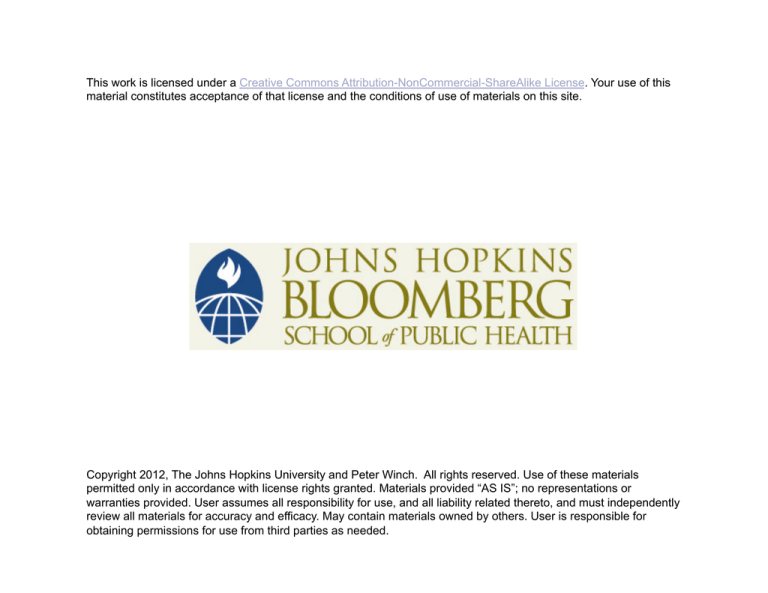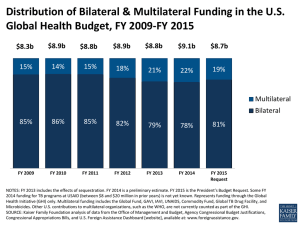
This work is licensed under a Creative Commons Attribution-NonCommercial-ShareAlike License. Your use of this
material constitutes acceptance of that license and the conditions of use of materials on this site.
Copyright 2012, The Johns Hopkins University and Peter Winch. All rights reserved. Use of these materials
permitted only in accordance with license rights granted. Materials provided “AS IS”; no representations or
warranties provided. User assumes all responsibility for use, and all liability related thereto, and must independently
review all materials for accuracy and efficacy. May contain materials owned by others. User is responsible for
obtaining permissions for use from third parties as needed.
Career paths related to community
and behavioral interventions
Peter Winch
Health Behavior Change at the Individual,
Household and Community Levels
224.689
Career paths related to community
and behavioral interventions
Four of careers related to
behavior change in public health
1. Developing and implementing
interventions
– National-level
– District or community level
2. Research – advocacy – policy in nonacademic institutions
3. Research – advocacy – policy in academic
institutions
4. Bilateral and multilateral organizations
#1 - Developing and
implementing interventions
#1 - Developing and
implementing interventions
Three kinds of organizations
– Primary focus on behavior change and
communication
– Broader focus, behavior change is one
of many activities in the mix
– Focus on one health problem or set of
problems e.g. reproductive health
Primary focus on behavior change
and communication
FHI 360 www.fhi.org
– The part in DC that once was
Academy for Educational Development
Center for Communication Programs (CCP)
www.jhuccp.org
The Manoff Group www.manoffgroup.com
PSI www.psi.org
Weinreich Communications www.socialmarketing.com
Primary focus on behavior
change and communication
Advantages
Depth and expertise in
specific components
e.g. materials
development, video
production etc.
Often have more
sophisticated
evaluation methods
Career ladder in
behavior change and
communication
Disadvantages
Can feel constraining
to work only on
behavior change and
communication
Opportunity to work
on other aspects of
health care may be
limited
Overexposure to
company logos
Broader focus, behavior change is
one of many activities in the mix
Contractors
– Research Triangle Institute - www.rti.org
– John Snow International - www.jsi.com
– Management Sciences for Health
www.msh.org
– Chemonix - www.chemonix.com
NGOs
– CARE, World Vision, Save the Children,
Catholic Relief Services etc.
Broader focus, behavior change is
one of many activities in the mix
Advantages
Large organizations, a
lot of variety in the
work, opportunity to
work on range of
issues
Potential for
integrated approach
to problems
Disadvantages
Behavior change/
communication
approach may not be
well developed
Fewer colleagues to
work with on behavior
change, specialized
tasks may be
contracted out
Focus on one health problem
or set of related problems
Example: Focus on reproductive health
– Pathfinder International
www.pathfind.org
– Marie Stopes International
www.mariestopes.org
– FHI www.fhi.org (Non-AED part)
– JHPIEGO www.jhpiego.net
Others in maternal health, HIV/AIDS,
malaria, TB, trachoma, nutrition etc.
Focus on one health problem
or set of problems
Advantages
Disadvantages
Narrower focus allows Tendency to
you to master the
implement categorical
different aspects of
(disease-specific)
prevention and control
interventions
(i.e. feel like you know Difficult to address
something)
other community
Good institutional
problems
linkages: journals,
conferences,
associations
#2 - Research – advocacy – policy
in non-academic institution
#2 - Research – advocacy – policy
in non-academic institution
Policy-oriented research
Reviews and policy analysis
Advocacy and policy dialog
Often have gender focus, raise issues that
are avoided by government agencies
Research – advocacy – policy in
non-academic institution
Gender focus:
– International Center for Research on
Women (ICRW) www.icrw.org
– Population Council www.popcouncil.org
– Guttmacher Institute
www.guttmacher.org
– International Women’s Health Coalition
www.iwhc.org
Research – advocacy – policy in
non-academic institution
Various topics:
– Rockefeller Foundation
www.rockfound.org
– Ford Foundation www.fordfound.org
– Center for Global Development
www.cgdev.org
– Center for Strategic and International
Studies www.csis.org
– Numerous smaller organizations
Research – advocacy – policy in
non-academic institution
Advantages
Possibility for
intellectuallychallenging work with
less stress than in
academia
Often there is a
compelling vision
behind the work
Disadvantages
Lack of contact with
the field can be
frustrating: Only office
work and reading
PhD often a
requirement
#3- Research – advocacy – policy in
academic institution
#3- Research – advocacy – policy in
academic institution
Larger programs: London School, Liverpool,
Karolinska Institutet, JHSPH, Harvard,
Boston, UNC, Columbia, Tulane, U
Washington
Many smaller programs in Global Health,
behavior change etc., some with <5 faculty
Research – advocacy – policy in
academic institution
Advantages
Connected to various
networks
Institution gives
credibility & prestige
Access to other
specialized areas of
knowledge
Opportunity for
teaching
Disadvantages
Needs doctoral degree
Social/behavioral work
tends to done by
relatively small group
Many demands on
time
#4 - Bilateral and multilateral
organizations
#4 - Bilateral and multilateral
organizations
Multilateral: WHO, UNAIDS, World Bank,
UNICEF
Bilateral: USAID, DfID, GTZ, CIDA
Bilateral and multilateral
organizations
Advantages
Less need to look for
funding
Constantly changing
work and projects
May be considerable
scope for research
and analysis
Disadvantages
Internal politics can
be disturbing
No direct contact with
the field except for
official visits
A lot of sitting in
meetings
US locations
Typical
donors
Examples of organizations
Boston
USAID,
JSI, MSH, Partners in Health,
Foundations Harvard, BU
Foundations Pop Council, Ford F., IWHC,
New York
Rockefeller F., Columbia, many
small foundations
USAID, NIH, JHU, CCP, JHPIEGO, CRS,
Baltimore
Gates
World Relief, Lutheran WR
Washington USAID, NIH, GW, AED, Africare, CGD,
Gates
ICRW, APHA, CSIS
CDC, USAID Carter Center, CARE, Emory
Atlanta
Seattle
Gates
PATH, U Washington
Future work in promotion of
sustainable lifestyles
The challenge
This will be the largest behavior change
initiative ever
This will involve all countries, all sectors of
the economy, all income levels, all ethnic
groups
Direct threat to the underpinnings of the
consumer economy
– Return ‘consume’ to its original meaning
of ‘use up destructively’ e.g.
TB=consumption
Types of jobs that might appear
Social marketing of sustainable behaviors
Promotion of environmental sustainability
(reduction of energy use, waste production
& use of private cars) for:
– Hospitals and health care organizations
– Municipal governments
– Private businesses
Mitigation of effect of climate change:
Domestic and international
Various books
Why We Disagree About Climate Change:
Understanding Controversy, Inaction and
Opportunity - Mike Hulme
Plan C: Community survival strategies for peak oil
and climate change – Pat Murphy
Overshoot - William Catton
Peak Everything: Waking Up to the Century of
Declines - Richard Heinberg
Environmental Values in American Culture Kempton, Boster & Hartley
The Collapse of Complex Societies - Charles
Tainter
Ultimatum: Matthew Glass
Collapse of Complex Societies
by Charles Tainter
Simple societies are faced with problems in food
production, security, public works
They respond to these problems by becoming
increasingly complex
Overhead costs come with complexity: people
working in administration rather than production,
maintaining infrastructure, raising taxes
New problems require yet additional complexity
Point is reached where overhead costs generated
result in diminishing returns in terms of
effectiveness
Society eventually collapses into smaller, less
complex units



